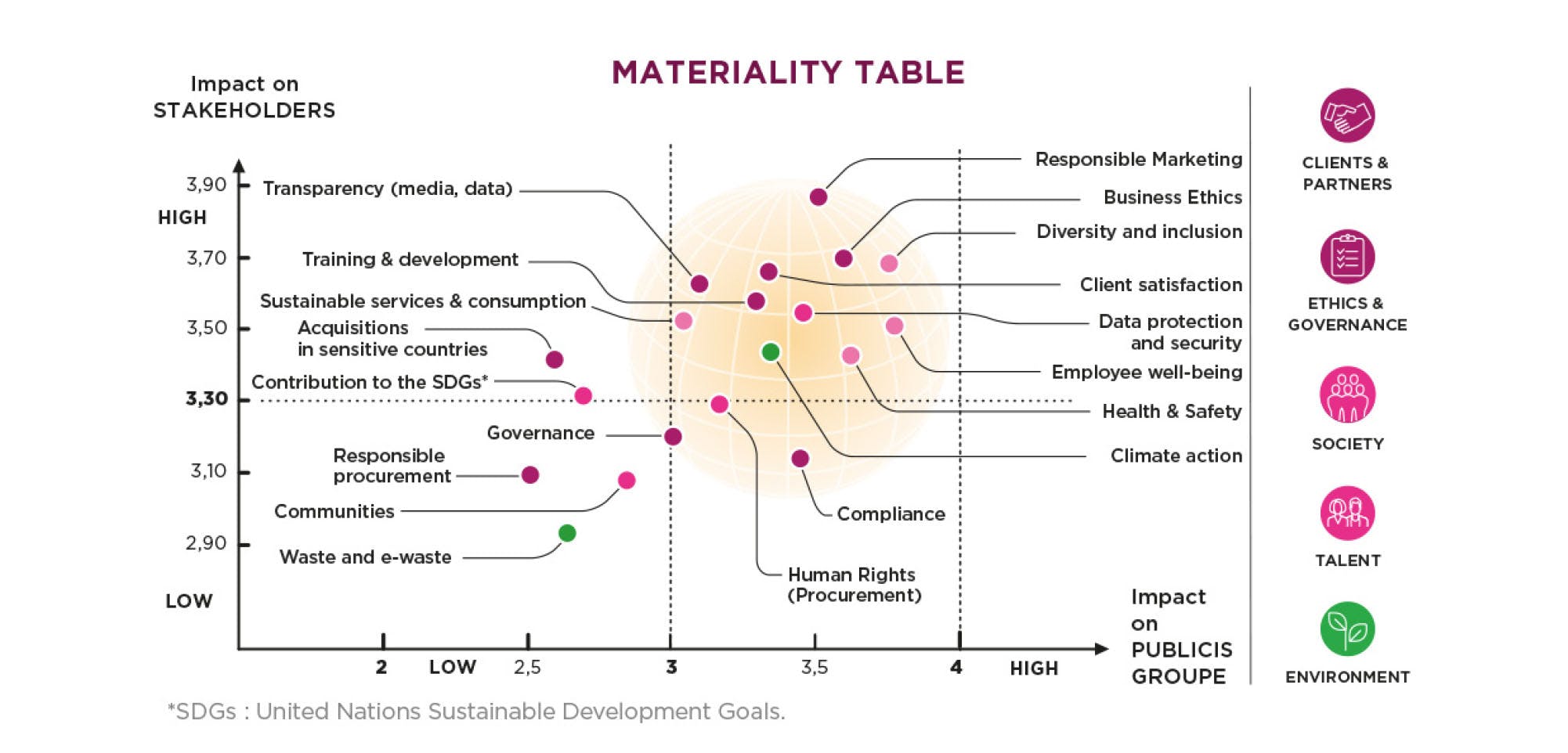Materiality of ESG issues and stakeholder consultation
In 2020, the consultation of stakeholders in the form of individual interviews and workshops with around a hundred people – clients, investors, and employees in small Groupes, confirmed the three ESG priorities of the Gro
- Diversity, Equity & Inclusion and the fight for Social Justice;
- Responsible marketing and Business Ethics;
- Fight against climate change.

Materiality table
Clients & Partners
Responsible Marketing
- Impact on Publicis Groupe: approximately 3.6
- Impact on stakeholders: approximately 3.86
Client satisfaction
- Impact on Publicis Groupe: approximately 3.4
- Impact on stakeholders: approximately 3.70
Training & development
- Impact on Publicis Groupe: approximately 3.3
- Impact on stakeholders: approximately 3.60
Transparency (media, data)
- Impact on Publicis Groupe: approximately 3.1
- Impact on stakeholders: approximately 3.68
Society
Data protection and security
- Impact on Publicis Groupe: approximately 3.5
- Impact on stakeholders: approximately 3.60
Human rights (Procurement)
- Impact on Publicis Groupe: approximately 3.2
- Impact on stakeholders: approximately 3.30
Communities
- Impact on Publicis Groupe: approximately 2.9
- Impact on stakeholders: approximately 3.10
Contribution to the SDGs *
- Impact on Publicis Groupe: approximately 2.6
- Impact on stakeholders: approximately 3.30
Talent
Diversity and inclusion
- Impact on Publicis Groupe: approximately 3.7
- Impact on stakeholders: approximately 3.70
Employee well-being
- Impact on Publicis Groupe: approximately 3.7
- Impact on stakeholders: approximately 3.52
Health & Safety
- Impact on Publicis Groupe: approximately 3.6
- Impact on stakeholders: approximately 3.46
Sustainable services & consumption
- Impact on Publicis Groupe: approximately 3.1
- Impact on stakeholders: approximately 3.55
Ethics & governance
Business ethics
- Impact on Publicis Groupe: approximately 3.6
- Impact on stakeholders: approximately 3.70
Compliance
- Impact on Publicis Groupe: approximately 3.5
- Impact on stakeholders: approximately 3.18
Responsible procurement
- Impact on Publicis Groupe: approximately 2.5
- Impact on stakeholders: approximately 3.10
Gouvernance
- Impact on Publicis Groupe: approximately 3
- Impact on stakeholders: approximately 3.20
Acquisitions in sensitive countries
- Impact on Publicis Groupe: approximately 2.6
- Impact on stakeholders: approximately 3.40
Environment
Climate action
- Impact on Publicis Groupe: approximately 3.4
- Impact on Publicis Groupe: approximately 3.4
Waste and e-waste
- Impact on Publicis Groupe: approximately 2.6
- Impact on stakeholders: approximately 2.93
In order to anticipate the various European regulatory changes, the Groupe has initiated a new stakeholder consultation process in order to update its materiality table in 2023. This analysis will be based on the concept of dual materiality, in accordance with the Corproate Sustainability Disclosure Directive (CSRD) published on December 16, 2022. The approach is different from a so-called simple materiality. Dual materiality is based on the premise of examining, on the one hand, the financial materiality with the impact of the deterioration of societal and environmental conditions on the Company’s activity and its financial impact, and on the other hand, the materiality of impact with the measurement of the Company’s activities on these same conditions, including in the financial dimension.
The results of this analysis will be shared and reviewed by the ESG Committee and the Audit Committee. The dual materiality matrix will be regularly updated, particularly with regard to the final version of the European sustainability reporting standards (ESRS) developed by EFRAG, which the European Commission should adopt in 2023.
This Groupe-wide stakeholder consultation work is conducted with the assistance of Salterbaxter (an expert subsidiary in sustainable strategy & sustainability consulting) under a contract using recognized materiality analysis methodologies. This work is managed by the Groupe’s CSR/ESG Department in close collaboration with all other corporate departments and Business teams.
ESG risk analysis and management
Historically, ESG risks have been included in the Groupe’s overall risk map (see Chapter 2 of this document), in particular risks relating to Talent and social issues as well as environmental and climate risks. Changes in these risks are also analyzed and monitored as part of the application of the Duty of Care Law (see Section 4.2.4). This Groupe risk matrix is monitored by the Strategy and Risk Committee of the Supervisory Board, as well as by the Board’s Audit Committee. Topics are treated more in-depth as part of the work of the ESG Committee and the monitoring of the Company’s three main ESG priorities.
